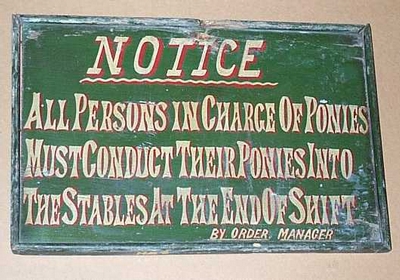Notice for correct handling of ponies at the end of the shift
© National Coal Mining Museum for England (Photo: National Coal Mining Museum for England)
© National Coal Mining Museum for England (Photo: National Coal Mining Museum for England)
It is recorded that the peak of employment for horses underground in UK was in 1913 which coincided with the Britain's maximum coal output, when around 70,000 were working. Their use declined as mechanical coal cutting and haulage systems became more efficient.
Actually the new cutting machines cut coal too quickly for horse transport and increasingly they were displaced by high capacity systems, at first locomotives but more recently conveyors. By the end of the 1930s there were around 32,000 horses underground and numbers continued to fall to around 6,400 in 1962, then 490 in 1973 and only 55 still working in major mines in the UK in 1984. By 1992, one deep mine, Ellington Colliery in Northumberland, England, still had 24 ponies which were used in salvage work. The last of these was retired in 1994 though this was not quite the end as a few remained in use in private drift mines in South Wales.
Actually the new cutting machines cut coal too quickly for horse transport and increasingly they were displaced by high capacity systems, at first locomotives but more recently conveyors. By the end of the 1930s there were around 32,000 horses underground and numbers continued to fall to around 6,400 in 1962, then 490 in 1973 and only 55 still working in major mines in the UK in 1984. By 1992, one deep mine, Ellington Colliery in Northumberland, England, still had 24 ponies which were used in salvage work. The last of these was retired in 1994 though this was not quite the end as a few remained in use in private drift mines in South Wales.


